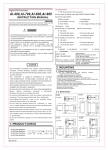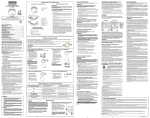Download Omni8µ Alarm Annunciator C1477-x
Transcript
Omni8µ Alarm Annunciator C1477-x SCOPE This is a User Manual supplied with the your product and provides information necessary to install, set-up and operate the product. This manual covers the following product Model Numbers: DATE Sep 1999 Nov 1999 Feb 2000 Model C1477-1 Description C1477-2 Omni8µ with 20-60Vdc Power Supply C1477-3 Omni8µ with 85-264Vac/dc Power Supply REVISION 1 2 3 Omni8µ with 10-15Vdc Power Supply COMMENTS Initial revision General Corrections during development. Released to Production COPYRIGHT AND PROTECTIVE NOTICES 1. The Copyright of this document and the associated drawings, is the property of Omniflex and is issued on condition that it is not copied, reprinted or reproduced or transmitted in any form or by any means, electronically, photocopying, mechanical or otherwise, nor its contents disclosed, either wholly or in part, without the consent in writing of, or in accordance with the conditions of a contract with Omniflex. 2. The publication of information in the document does not imply freedom from patent or other protective rights of Omniflex or others. 3. Although every intention is made to ensure that performance figures and data are accurate the company reserves the right to alter without notice any product or specification. Performance figures and data must therefore be specifically confirmed by the company before they become applicable to any tender, order or contract. 4. In the case of electrical components, enough data is included in the drawings to allow maintenance of the equipment. However, if component availability or substitution information is required please consult the factory for assistance, as it is impossible to include data on every component in this document. 5. This product is sold without liability for consequential loss of any description. C1477 User Manual Part No. 8.0101.013 Revision 3 (80101013R03.pdf) -2- © Omniflex Introduction The Omni8µ (pronounced “omni eight micro”) is a compact 8 point Alarm Annunciator/Status Indicator which is fully field configurable (via two simple-to-set 8-way switches) to meet a wide range of alarm and status indication applications. Although extremely compact in size, the Omni8µ is packed full of features normally found only in larger alarm annunciator systems. Available in a range of power supply options, the rugged Omni8µ is designed to fit directly into local electrical panels without the need for external power conditioning or interfacing for the lowest cost system implementation. With bright back-lit LED displays, the Omni8µ provides high visibility viewing of alarm and status information replacing the need for independent status indicators without consuming valuable panel space. Integral control pushbuttons and an audible device minimise the installation time and cost. THE OMNI8µ µ 8 point Alarm Annunciator/Status Indicator. C1477 User Manual Part No. 8.0101.013 Revision 3 (80101013R03.pdf) -3- © Omniflex Table of Contents 1. GENERAL DESCRIPTION ........................................................................................... 5 1.1 Features .................................................................................................................. 5 1.2 Front View showing Display Layout ....................................................................... 5 1.3 Rear View showing Terminal Layout...................................................................... 6 1.4 Left-Hand-Side View showing Switch Layout......................................................... 6 1.5 Installation and Set-up Procedure .......................................................................... 6 2. SETTING THE CONFIGURATION SWITCHES .......................................................... 7 2.1 Introduction.............................................................................................................. 7 2.2 Selecting the input sense........................................................................................ 7 2.3 Selecting the alarm sequences .............................................................................. 7 2.4 Selecting the Group Alarm (G.A.) Relay Output Function ..................................... 8 2.5 Selecting the Inhibit Input Mode ............................................................................. 8 2.6 Inhibit Input Sense .................................................................................................. 8 3. MECHANICAL INSTALLATION.................................................................................. 10 3.1 Installing the Omni8µ in a panel. .......................................................................... 10 4. ELECTRICAL INSTALLATION ................................................................................... 11 4.1 Introduction............................................................................................................ 11 4.2 Connection Table .................................................................................................. 11 4.3 Connecting the alarm inputs................................................................................. 11 4.4 Connecting the Relay............................................................................................ 12 4.5 Connecting the power supply ............................................................................... 12 5. PREPARING THE BACKLIT DISPLAY LEGEND ...................................................... 12 5.1 Overview ............................................................................................................... 12 5.2 Creating the Legend Film ..................................................................................... 12 5.3 Inserting the Legend into the Annunciator ........................................................... 12 6. OPERATION ............................................................................................................... 13 6.1 Power-up ............................................................................................................... 13 6.2 Normal Operation.................................................................................................. 13 6.3 Test Functions....................................................................................................... 13 6.3.1 Overview of the Test Functions .............................................................................................. 13 6.3.2 Pressing the Test Button ......................................................................................................... 13 6.3.3 Fault Indication on Circuit Test ............................................................................................... 13 6.3.4 Manually invoking the Circuit Test Function. .......................................................................... 14 6.3.5 The “Marching Sequence” Circuit Test Display ...................................................................... 14 6.4 Use of the inhibit input .......................................................................................... 14 7. SPECIFICATIONS ...................................................................................................... 15 8. ALARM SEQUENCE DIAGRAMS .............................................................................. 17 C1477 User Manual Part No. 8.0101.013 Revision 3 (80101013R03.pdf) -4- © Omniflex 1. GENERAL DESCRIPTION 1.1 Features • • Compact 48x96mm DIN panel mounted construction for minimum space utilisation. Bright Back-lit alarm/status display for easy viewing. • Solid State LED display technology for high reliability and low power consumption -no lamps to replace. • User-created Display legends on standard laser/inkjet printer using software templates supplied – no window engraving required. • Integral Full-Function Alarm Annunciator for independent critical alarm point monitoring. • Integral audible device and control pushbuttons for ease of installation and use. Relay output for common group alarm or external audible device control. Removable terminals for easy installation and maintenance. Wetting voltage supplied to the inputs to allow potential free input contacts to be directly connected. Integral power supply for direct connection to available power source. Switch selectable Normally Open or Normally Closed input contact selection. • • • • • • 22 Switch selectable configurations covering all popular alarm sequences and configurations. 1.2 Front View showing Display Layout Input 1 Input 2 Input 3 Input 4 Input 5 Input 6 Input 7 Input 8 SILENCE ACK RESET TEST Figure 1-1 Front View C1477 User Manual Part No. 8.0101.013 Revision 3 (80101013R03.pdf) -5- © Omniflex 1.3 Rear View showing Terminal Layout Omni8µ L N INPUTS 1 2 3 4 5 6 7 8 C + 1 2 3 4 5 6 7 8 9 10 11 12 13 14 15 16 Figure 1-1 – Rear View 1.4 Left-Hand-Side View showing Switch Layout SW1 Sequence Selection SW2 Input Sense Selection 1 2 3 4 5 6 7 8 ON 1 2 3 4 5 6 7 8 ON Figure 1-1 – Side View showing 8-way Set-up Switches 1.5 Installation and Set-up Procedure The following steps should be implemented in the order shown to configure and install an Omni8-µ alarm annunciator: 1. Configure the set-up switches to the required settings. The mounting brackets are designed to cover the set-up switches so it important to set these before mounting the unit into the panel. (See section 2) 2. Install the unit in the panel. (See section 3) 3. Wire the inputs, power supply and relay output. (See section 4) 4. Print and install the back-lit display legend. (See section 5) 5. Power up and check your installation. (See section 6) C1477 User Manual Part No. 8.0101.013 Revision 3 (80101013R03.pdf) -6- © Omniflex 2. SETTING THE CONFIGURATION SWITCHES 2.1 Introduction The unit is configured for operation by setting the two 8-way set-up switches found on the left hand side of the Omni8µ. The layout of these switches can be seen in Figure 1-1 – Side View showing 8-way Set-up Switches. SW1 is used to set the operational configuration of the Omni8µ. SW2 is used to set the sense of the eight input contacts – normally open or normally closed. Each set-up switch has 8 individual miniature switches, numbered from 1 to 8. Each of these miniature switches can be referred to separately: for example, the 8 miniature switches on SW1 are referred to as SW1-1 to SW1-8. 2.2 Selecting the input sense (normally open or normally closed) The input sense for each of the 8 input contacts is selected by setting the corresponding switch of SW2. e.g. SW2-1 sets the contact sense for input 1 and SW2-8 sets the contact sense for input 8. When the switch is OFF (up) then the input is set to NORMALLY OPEN. (i.e. the input will enter the alarm state when the input contact is closed.) When the switch is ON (down) then the input is set to NORMALLY CLOSED. (i.e. the input will enter the alarm state when the input contact is opened.) 2.3 Selecting the alarm sequences The 8 inputs of the Omni8µ operate as a single group of alarms all with the same alarm/display function, which can be any one of the available alarm/display sequences listed in Table 2-1 (detailed block diagrams of each alarm/display sequence are provided in section 8.) Set switch SW1-1 to SW1-5 according to the selected sequence in Table 2-1. The sequence switch settings can be changed at any time. Any sequence switch changes made while the unit is running in the normal mode of operation will cause the OMNI8µ to revert to the power-up routine as described in section 6.1. Press the ACKNOWLEDGE button to return the unit to normal operation. C1477 User Manual Part No. 8.0101.013 Revision 3 (80101013R03.pdf) -7- © Omniflex 2.4 Selecting the Group Alarm (G.A.) Relay Output Function The G.A. relay provided internally offers a changeover contact on the rear terminals. SW1-6 and SW1-7 are used to set the mode of operation of this relay. There are four modes to choose from: 1. Relay follows input The relay is normally energised. Any abnormal input will de-energise the relay. The relay will re-energise when all inputs return to their normal states, regardless of the state of the alarm lamps. This is useful for tracking the actual state of the inputs. 2. Relay follows alarm state The relay is normally energised. Any alarm state will de-energise the relay. The relay will return to normal when all alarm states have returned to normal. (i.e. the entire display is off) This is useful for tracking the actions of a local operator in clearing the problem. If a ‘fleeting’ alarm sequence is chosen, the relay will remain de-energised until the operator clears the display. 3. Relay acts as horn The relay is normally de-energised. The relay will energise whenever the internal audible device sounds. The relay will de-energise when the internal audible is silenced (normally by pressing the Silence or Acknowledge Pushbutton). This is useful in environments where the local internal audible will not be heard. 4. Relay acts in Multiple Reflash Mode The relay is normally energised. The relay is de-energised by the first abnormal input state. Upon each subsequent abnormal input state, the relay will momentarily energise (for about 1 second), then return to the de-energised state. This is useful when the relay contact is used for example to trigger a dial up alarm, and if subsequent inputs going into alarm must also trigger the dial-up alarm. Referring to Table 2-1, select one of the 4 relay modes by setting switches SW1-6 and SW1-7 to the appropriate positions. 2.5 Selecting the Inhibit Input Mode Input 8 may be used as a special “input inhibit” input. In this mode, when the Input 8 is in the normal state, the other 7 inputs perform normally. When the input 8 is in the alarm state, then all further input changes are ignored, preventing any further alarms to be displayed. In this mode, the lamp 8 will follow the state of the inhibit function. When the alarm system is inhibited, the lamp 8 will be on. When the alarm system is operating normally and not inhibited, then this lamp will be off. 2.6 Inhibit Input Sense SW2-8 contact sense selection switch is used regardless of whether the input 8 is used as a normal alarm or as an input inhibit. C1477 User Manual Part No. 8.0101.013 Revision 3 (80101013R03.pdf) -8- © Omniflex Table 2-1: The Sequence Switch Settings SEQUENCE SW1 SEQ. NO. 1 2 3 4 5 6 7 8 DESCRIPTION ISA DESIGN ATION 0 0 0 0 0 0 SERVICE MODE (consult factory for service information) 1 1 0 0 0 0 LAMP FOLLOWS INPUT 2 0 1 0 0 0 MOMENTARY (FLEETING) ALARM, MANUAL RESET 3 1 1 0 0 0 ALARM ONLY (NON-LATCHING INPUTS) AUTO RESET 4 0 0 1 0 0 MOMENTARY ALARM, MANUAL RESET WITH ALARM RINGBACK 5 1 0 1 0 0 FIRST OUT, MULTIPLE GROUPS, MANUAL RESET 6 0 1 1 0 0 FIRST OUT, MANUAL RESET, AUTO RESET ON SUBSEQUENT ALARMS 7 1 1 1 0 0 FIRST OUT, SINGLE GROUP, MANUAL RESET, FIRST OUT CONTINUOUS FLASH 8 0 0 0 1 0 FIRST OUT, MANUAL RESET, SUBSEQUENT ALARMS WITHOUT HORN 9 1 0 0 1 0 10 0 1 0 1 11 1 1 0 1 12 0 0 1 13 1 0 16 0 0 18 0 21 T TIME DELAY -- -- M-1 -- A-1-4 -- R-1-10 -- F2M-1 -- F3A-1-3 -- -- -- F1M-1 -- MOMENTARY ALARM, MANUAL RESET, AUTO SILENCE AFTER TIME DELAY. -- 60 seconds 0 MOMENTARY ALARM, MANUAL RESET, REALARM AFTER TIME IF STILL ABNORMAL. -- 60 seconds 0 MOMENTARY ALARM, MANUAL RESET, CONSTANT FLASH (FOR MOTOR ALARMS). -- -- 1 0 MOMENTARY ALARM, AUTO RESET, TIME DELAY ON RETURN TO NORMAL. -- 60 seconds 1 1 0 PULSE MONITORING ALARM; MANUAL RESET -- -- 0 0 1 INPUTS 1-4 SEQUENCE 1; INPUTS 5-8 SEQUENCE 27 (FOR MOTOR ALARMS) 1 0 0 1 MOMENTARY ALARM, AUTO RESET 1 0 1 0 1 FIRST OUT, MULTIPLE GROUPS, AUTO RESET 23 1 1 1 0 1 FIRST OUT, SINGLE GROUP, AUTO RESET, FIRST OUT CONTINUOUS FLASH 24 0 0 0 1 1 FIRST OUT, AUTO RESET, SUBSEQUENT ALARMS WITHOUT HORN 25 1 0 0 1 1 26 0 1 0 1 27 1 1 0 1 29 1 0 1 1 --- -- F2A-1 -- -- -- F1A-1 -- MOMENTARY ALARM, AUTO RESET, AUTO SILENCE AFTER TIME DELAY. -- 60 seconds 1 MOMENTARY ALARM, AUTO RESET, REALARM AFTER TIME IF STILL ABNORMAL. -- 60 seconds 1 MOMENTARY ALARM, AUTO RESET, CONSTANT FLASH (FOR MOTOR ALARMS) -- -- 1 PULSE MONITORING ALARM, AUTO RESET -- -- FOLLOWS INPUT 0 0 FOLLOWS ALARM STATE 1 0 FOLLOWS HORN 0 1 NOTE: RELAY OUTPUT (see Section 2.4 for details) In the above sequences, the switch ACTS AS MRF (REFLASH) 1 1 sense is as follows: INPUT 8 AS NORMAL 0 INPUT 8 ACTS AS INHIBIT 1 WHEN THIS SWITCH IS ON, INPUT 8 MAY BE USED TO INHIBIT ALL OTHER ALARMS 1 TO 7. IN THIS MODE LAMP 8 MEANS THE ANNUNCIATOR IS INHIBITED(see section 2.5 for details) C1477 User Manual Part No. 8.0101.013 Revision 3 (80101013R03.pdf) -9- “1” = switch in on position “0” = switch in off position © Omniflex 3. MECHANICAL INSTALLATION The overall dimensions and panel cut-out size of a single unit are given in the following Figure: Fascia Din 48x96mm SLIDES CLAMP Omni8u AGAINST PANEL PANEL CUTOUT 48 42 44 DIMENSIONS IN mm 92 190 MAXIMUM PANEL THICKNESS: 8mm Figure 3-1: Mounting an Omni8µ µ 3.1 Installing the Omni8µ µ in a panel. Remember to set the 8 way set-up switches on the side of the unit before installing in the panel. Remove the two slide clamps from the unit by lifting the ratchet levers and sliding them off the rear of the unit. Insert the Omni8µ into the panel from the front. Replace the slide clamps by sliding them on from the rear. Make sure that they are secure against the front plate. Ensure the ratchets are engaged to secure the slide in position. The unit can be further secured by turning the screw in each clamp slightly. CAUTION: Do not over-tighten, as it may cause the slide clamp ratchets to dislodge. C1477 User Manual Part No. 8.0101.013 Revision 4 (80101013R04.pdf) - 10 - © Omniflex 4. ELECTRICAL INSTALLATION 4.1 Introduction All electrical connections to the Omni8µ are made on the rear of the unit on plug-in terminals provided(refer to Figure 1-1). 4.2 Connection Table Terminal Number 1 2 3 4 5 6 7 8 9 10 11 12 13 14 15 16 Description Input 1 Input 2 Input 3 Input 4 Input 5 Input 6 Input 7 Input 8 Common Input Excitation Voltage ( +12volts for contact wetting) Relay Change-over Contact – Normally Open Connection Relay Change-over Contact – Common Connection Relay Change-over Contact – Normally Closed Connection No Connection Earth + dc Power Connection Live ac Power Connection - dc Power Connection Neutral ac Power Connection 4.3 Connecting the alarm inputs The Omni8µ is operated with potential free contacts connected to the input terminals. The common terminal provided (marked C) supplies a +12 volt wetting potential used to power these contacts. Omni8u C 8 7 6 5 4 3 2 1 Potential-free Input contacts Figure 4-1 Inputs Connection Diagram C1477 User Manual Part No. 8.0101.013 Revision 4 (80101013R04.pdf) - 11 - © Omniflex 4.4 Connecting the Relay The relay contact shown in the Figure 1-1 is shown with the relay coil in the de-energised state. i.e. with no power applied. The normally open contact refers to the relay convention of the contact in the de-energised state of the relay coil. In some of the modes of operation of this relay, the relay coil will be energised with no alarms present. The normal state of the system would therefore be for the contact across the C and NO terminals of the relay to be closed. 4.5 Connecting the power supply Power supply connections are made to the plug-on terminals according to the following table: Table 2-3: Power supply connections Supply Connector Terminals Voltage 14 15 16 dc Earth positive (+) negative (-) ac Earth Live Neutral 5. PREPARING THE BACKLIT DISPLAY LEGEND 5.1 Overview Legends are created for the Omni8µ on a laser or inkjet printer using the software templates provided with the product. Templates for popular programs are supplied on a 3,5” ‘stiffy’ diskette with your Omni8µ. These are for Microsoft Word and Microsoft Powerpoint to run on an IBM compatible computer running the, Windows95, Windows98 or WindowsNT operating systems. There is also a README.TXT file on this disk. Run this first to see which version of program you must run to use the supplied templates. 5.2 Creating the Legend Film To create the legend, run whichever of the programs you are familiar with. Load the appropriate template supplied and then fill in your legend detail. Print it onto overhead transparency film (the type used for overhead presentations). A sheet is included with the product. Cut this along the cut marks which will print onto the film and then insert into the Omni8µ. (We suggest that you test your printout on plain-paper first to ensure that all aspects of your Legend Film are to your liking before printing on to the actual film supplied.) Please note that the supplied templates have been tested on a wide range of printers. Your particular printer may scale the image slightly differently. While the front grid markings should accommodate this tolerance, in exceptional circumstances you may have to alter the grid spacing on the template supplied. This needs to be done once only and will then be set for your printer. 5.3 Inserting the Legend into the Annunciator Cut the film to size, unclip the Omni8µ front-plate by pulling on the upper edge, and insert the film into the recess behind the front-plate. Replace the front-plate. C1477 User Manual Part No. 8.0101.013 Revision 4 (80101013R04.pdf) - 12 - © Omniflex 6. OPERATION 6.1 Power-up When power is applied to the Omni8µ, the unit commences an automatic, built-in circuit test routine. This results in the unit sounding the audible for approximately half a second followed by the cyclic illumination of each lamp in turn from 1 to 8 and back to 1 again etc. in a “marching sequence”. If no internal faults are detected in the unit, then this test mode display continues until the Acknowledge Pushbutton is pressed or until an input enters the alarm state. If a fault was detected, then the unit will display a fault indication by continuously flashing one of the lamps. If this occurs, then the unit must be sent for service. If a new alarm occurs while the Omni8µ is in this test routine, the unit will immediately revert to its normal mode of operation and will deal with the alarm state according to the pre-selected alarm sequence. 6.2 Normal Operation During the normal operation, the Omni8µ will act upon any alarm states according to its pre-set alarm sequences. (The instructions for setting-up these sequences are given in SECTION 3.3). Section 8 provides detailed block diagrams for the function of each alarm sequence. When an alarm condition occurs and the horn sounds, the operator should depress the relevant pushbuttons, where necessary, according to the pre-selected alarm sequence. When the Omni8µ is put into its test routine by depressing the TEST pushbutton, any existing alarm states are “remembered” and the alarm annunciator will revert to its previous state when it returns to its normal mode of operation. If a new alarm state occurs while the Omni8µ is performing its test routine, the unit will immediately revert to its normal mode of operation and deal with the alarm state according to the pre-selected alarm sequence. 6.3 Test Functions 6.3.1 Overview of the Test Functions The Test button operates as a combined lamp test and circuit test function. No information is lost during the entire test routine, and each alarm display returns to the exact state it was in before the test. 6.3.2 Pressing the Test Button When the Test button is pressed, the unit checks the results of its regular full circuit test, and if all checks performed pass, then a normal lamp test is performed by illuminating all of the lamps while the Lamp Test Pushbutton is held down. If the circuit Test fails then the unit enters its “marching sequence” test routine described in Section 6.3.5 and the test failure code will be displayed by flashing one of the lamps continuously. In this way, the display/annunciator Test button acts both as a Lamp Test and Circuit Function. 6.3.3 Fault Indication on Circuit Test If a fault is found in one of the tests performed, then the unit enters its full “marching lamp sequence”, with, in addition, one or more of the lamps flashing continuously to indicate the fault located. This is described in detail in Section 6.3.5 C1477 User Manual Part No. 8.0101.013 Revision 4 (80101013R04.pdf) - 13 - © Omniflex 6.3.4 Manually invoking the Circuit Test Function. As a confidence measure, the unit may be placed in the full “marching sequence” Circuit Test Mode at any time by holding down the Silence button and then pressing the Test Button. See section 6.3.5 6.3.5 The “Marching Sequence” Circuit Test Display This routine is entered upon the following conditions: • Upon power up. • If the Test button is pressed and a fault is detected in the unit. • By holding down the Silence button and then pressing the Test button manually enters this function. • Any time during normal operation, if the unit during its regular self-test routines detects a fault. This test routine begins by activating the horn output circuit for approximately one second. The operator should therefore check that the horn sounds for this short period. Immediately after this half-second period, if the Omni8µ is functioning correctly, the following visual indication will occur: The display will begin a “marching light” sequence, with each display window illuminating and then extinguishing, one at a time, starting with the display point 1 (top left-hand window) and ending with the display point 8 (bottom right-hand window). All display windows will then remain extinguished for a brief moment. The “marching” sequence will then begin again, and this procedure of “marching” sequence followed by the brief “blank” display period will be repeated continuously until the ACKNOWLEDGE pushbutton is depressed, or until an input changes state. This marching sequence indicates that the alarm annunciator has passed all its own internal tests and is functioning correctly. If the lamp display exhibits any other pattern then a fault has been detected, and the unit should be returned for repair. To exit the test mode and begin normal operation, the ACKNOWLEDGE pushbutton should be pressed. The pushbuttons may also be tested in this mode: If the SILENCE button is depressed - lamp No. 1 flashes continuously. If the ACK button is depressed - the annunciator reverts to normal operation. If the RESET button is depressed - lamp No. 3 flashes continuously. If the TEST button is depressed - lamp No. 4 flashes continuously. If any other lamp flashes continuously, then the unit has detected a fault and must be returned to the factory for repair. If a new alarm occurs while the Omni8µ is in this test routine, the unit will immediately revert to its normal mode of operation and will deal with the alarm state according to the pre-selected alarm sequence. 6.4 Use of the inhibit input When SW1-8 is off, then input 8 operates in the normal fashion. When SW1-8 is switched on, then input 8 is converted into an inhibit input as operates as follows: If input 8 is in the abnormal condition all of the other alarm inputs will be disabled from causing a new alarm. All other functions of the unit will remain unaffected. C1477 User Manual Part No. 8.0101.013 Revision 4 (80101013R04.pdf) - 14 - © Omniflex 7. SPECIFICATIONS TERMINALS Connection Wire size : via 16 way plug-in terminal block : 1.5 sq. mm (17 SWG/15.5 AWG) recommended 2.5 sq. mm (15 SWG/13 AWG) maximum POWER SUPPLY Voltage: Maximum dc ripple Current consumption: Isolation test voltage (power supply to Input terminals): Model C1477-1 10-15Vdc 10% pk-to-pk 300mA None Model C1477-2 20-60Vdc 10% pk-to-pk 250mA 1500Vac rms Model C1477-3 85-264Vac/dc N/A 7VA/5W 1500Vac rms ALARM INPUTS Quantity and Type Contact Sense 8 potential free contacts normally open (N.O.) or normally closed (N.C.), selectable by DIP switch. Max open cct voltage: 15V dc between Common (positive) and all input terminals. Max closed cct current: 2 mA per input Max loop resistance to 200 ohms detect closed circuit Min loop resistance to 100 kilo-ohms detect open circuit Input Scan Rate 4 ms PUSHBUTTONS Quantity and Type Functions 4 Mounted on front panel Integral to Unit Silence, Acknowledge, Reset, Test RELAY CONTACT OUTPUT Quantity and Type 1 Potential-free changeover relay contact (FORM C) Contact rating : 2 A, 30 V dc / 0.5 A, 250 V ac Isolation 1000Vac rms between contact and other circuits Relay operating modes: 4 types to choose from (selectable by DIP switch): i. Relay follows input states ii. Relay follows alarm states iii. Relay acts as horn output iv. Relay acts as “Multiple Re-Flash” alarm output CONFIGURATION SWITCHES Quantity 2 Type Each 8-way. One for Configuration; one for Input Sense Location on left-hand-side of unit (accessible only when slide clamp is removed) C1477 User Manual Part No. 8.0101.013 Revision 4 (80101013R04.pdf) - 15 - © Omniflex SEQUENCES Quantity ISA types supported DISPLAY WINDOWS Quantity and Type Window size Engraving details Fast Flash Rate Slow Flash Rate 22 (user selectable by DIP switches) M-1; A-1; A-1-4; R-1-10; F2M-1; F2A-1; F3A-1-3; F1M-1; F1A-1 8 Back-lit Red LED display 20 mm wide x 10 mm high (0.8” wide x 0,4” high) Printed on transparent film using laser or inkjet printer. Recommended text size: 3 rows of 20 characters 2.5mm 140 flashes per minute 35 flashes per minute TEMPERATURE RANGE Operating 0 ºC to +60 ºC (+32 ºF to +140 ºF) Storage -10 ºC to +70 ºC (+14 ºF to +158ºF) DIMENSIONS (SINGLE UNIT) Cut-out : 44mm (1.73”) horizontal 92 mm (3.62”) vertical Overall : 48 mm (1.89”) height 96 mm (3.78”) width 190 mm (6,22”) maximum depth behind panel, (excluding front panel) Panel thickness: : 1,6 mm (0,062”) minimum : 9,0 mm (0,354”) maximum WEIGHT Unpacked Packed : 300 g approximately : 480g approximately COMPLIANCE TO STANDARDS Safety Emissions Immunity – ESD Immunity – RF Fields Immunity – Fast Transients Supply Variations EN 60950:1995 EN 55011 and EN50081-2:1994 Group I, Class A IEC 61000-4-2:1995, level 3 IEC 61000-4-3:1995, level 3 IEC 61000-4-4:1995 2 kV – DC power port 1 kV – input/output lines IEC 61000-4-7:1991, 24 V dc +15% -10% ORDERING INFORMATION C1477-1 Omni8µ with PSU 10-15Vdc C1477-2 Omni8µ with PSU 20-60Vdc C1477-3 Omni8µ with PSU 85-265Vac/dc C1477 User Manual Part No. 8.0101.013 Revision 4 (80101013R04.pdf) - 16 - © Omniflex 8. ALARM SEQUENCE DIAGRAMS STATE 1 1 2 3 4 5 6 7 8 ON SEQUENCE SWITCH SETTING LAMP OFF HORN OFF RETURN WHILE NORMAL ABNORMAL STATE 2 LAMP ON HORN OFF Sequence 1 - Lamp Follows Input 1 2 3 4 5 6 7 8 ON SEQUENCE SWITCH SETTING STATE 1 LAMP OFF RESET WHILE NORMAL ABNORMAL HORN OFF STATE 4 STATE 3 STATE 2 LAMP ON LAMP FAST FLASH LAMP FAST FLASH ACK HORN OFF SIL HORN OFF HORN ON ACK Sequence 2 - Momentary (Fleeting) Alarm, Manual Reset, Timer option off 1 2 3 4 5 6 7 8 ON SEQUENCE SWITCH SETTING RETURN TO NORMAL STATE 1 LAMP OFF RETURN TO NORMAL ABNORMAL HORN OFF RETURN TO NORMAL STATE 4 STATE 3 STATE 2 LAMP ON LAMP FAST FLASH LAMP FAST FLASH ACK HORN OFF HORN OFF SIL HORN ON ACK Sequence 3 - Alarm Only (No Lock-in), Auto Reset, (Timer option off) C1477 User Manual Part No. 8.0101.013 Revision 4 (80101013R04.pdf) - 17 - © Omniflex STATE 1 1 2 3 4 5 6 7 8 ON SEQUENCE SWITCH SETTING RESET ABNORMAL LAMP OFF HORN OFF ABNORMAL ACK WHILE NORMAL STATE 4 LAMP SLOW FLASH HORN OFF ACK WHILE NORMAL STATE 3 STATE 2 LAMP FAST FLASH LAMP FAST FLASH SIL HORN OFF HORN ON ACK WHILE ABNORMAL STATE 5 RETURN TO NORMAL ACK WHILE ABNORMAL LAMP ON HORN OFF Sequence 4 - Momentary Alarm, Manual Reset, with Ringback, (Timer Option Off) STATE 1 1 2 3 4 5 6 7 8 ON SEQUENCE SWITCH SETTING T LAMP OFF HORN OFF RESET WHILE NORMAL RESET WHILE NORMAL ABNORMAL SUBSEQUENT FIRST OUT INACTIVE ACK STATE 7 STATE 6 STATE 5 LAMP ON LAMP ON LAMP ON HORN OFF ACK HORN OFF SIL FIRST OUT INACTIVE FIRST OUT INACTIVE ABNORMAL FIRST OUT HORN ON FIRST OUT INACTIVE ACK STATE 4 STATE 3 STATE 2 LAMP ON LAMP FAST FLASH LAMP FAST FLASH HORN OFF FIRST OUT INACTIVE ACK HORN OFF FIRST OUT ACTIVE SIL HORN ON FIRST OUT ACTIVE Sequence 5 - Momentary (Fleeting) Alarm, First Out Multiple Groups, Manual Reset, with Ringback. C1477 User Manual Part No. 8.0101.013 Revision 4 (80101013R04.pdf) - 18 - © Omniflex STATE 1 1 2 3 4 5 6 7 8 ON SEQUENCE SWITCH SETTING LAMP OFF ABNORMAL SUBSEQUENT HORN OFF RETURN TO NORMAL FIRST OUT INACTIVE RESET WHILE NORMAL ACK WHILE NORMAL ABNORMAL FIRST OUT ACK WHILE NORMAL STATE 7 STATE 6 STATE 5 LAMP ON LAMP LAMPFAST ON FLASH LAMP FAST FLASH HORN OFF FIRST OUT INACTIVE ACK WHILE ABNORMAL RESET WHILE ABNORMAL HORN OFF SIL FIRST OUT INACTIVE HORN ON FIRST OUT INACTIVE ACK WHILE ABNORMAL ACK STATE 4 STATE 3 STATE 2 LAMP SLOW FLASH LAMP INT. FAST/SLOW LAMP INT. FAST/SLOW HORN OFF ACK FIRST OUT ACTIVE HORN OFF SIL FIRST OUT ACTIVE HORN ON FIRST OUT ACTIVE Sequence 6 - Momentary (Fleeting) Alarm, First Out Manual Reset, Auto Reset on subsequent Alarms STATE 1 1 2 3 4 5 6 7 8 ON SEQUENCE SWITCH SETTING RESET WHILE NORMAL LAMP OFF ABNORMAL SUBSEQUENT HORN OFF RESET WHILE NORMAL FIRST OUT INACTIVE ABNORMAL FIRST OUT ACK STATE 7 STATE 6 STATE 5 LAMP ON LAMP ON LAMP ON HORN OFF ACK HORN OFF SIL FIRST OUT INACTIVE FIRST OUT INACTIVE HORN ON FIRST OUT INACTIVE ACK WHILE ABNORMAL ACK STATE 4 STATE 3 STATE 2 LAMP SLOW FLASH LAMP FAST FLASH LAMP FAST FLASH HORN OFF FIRST OUT ACTIVE ACK HORN OFF FIRST OUT ACTIVE SIL HORN ON FIRST OUT ACTIVE Sequence 7 - Momentary (Fleeting) Alarm, First Out Single Group, Manual Reset, First Out Continuous Flash C1477 User Manual Part No. 8.0101.013 Revision 4 (80101013R04.pdf) - 19 - © Omniflex STATE 1 1 2 3 4 5 6 7 8 ON SEQUENCE SWITCH SETTING RESET WHILE NORMAL ABNORMAL FIRST OUT LAMP OFF HORN OFF ABNORMAL SUBSEQUENT FIRST OUT INACTIVE ACK STATE 4 STATE 3 STATE 2 LAMP ON LAMP LAMPFAST ON FLASH LAMP FAST FLASH HORN OFF ACK FIRST OUT INACTIVE HORN OFF SIL HORN ON FIRST OUT ACTIVE FIRST OUT ACTIVE Sequence 8 - Momentary (Fleeting) Alarm; First Out Multiple Group; Manual Reset; No horn for subsequent alarms. STATE 1 1 2 3 4 5 6 7 8 ON SEQUENCE SWITCH SETTING RESET WHILE NORMAL ABNORMAL LAMP OFF HORN OFF TIMER OFF T STATE 4 STATE 3 LAMP ON LAMP FAST LAMP ON FLASH HORN OFF ACK HORN OFF TIMER OFF TIMER OFF STATE 2 LAMP FAST FLASH SIL HORN ON TIMER RUNNING TIME OUT ACK Sequence 9 - Momentary (Fleeting) Alarm; Manual Reset; Auto Silence after Time Delay. STATE 1 1 2 3 4 5 6 7 8 ON SEQUENCE SWITCH SETTING T RESET WHILE NORMAL ABNORMAL LAMP OFF HORN OFF TIME OUT WHILE ABNORMAL TIMER OFF TIME OUT WHILE ABNORMAL STATE 4 STATE 3 STATE 2 LAMP ON LAMP FAST LAMP ON FLASH LAMP FAST FLASH HORN OFF TIMER RUNNING ACK HORN OFF TIMER RUNNING SIL HORN ON TIMER OFF ACK Sequence 10 - Momentary (Fleeting) Alarm; Manual Reset; Re-alarm after time-out if still abnormal. C1477 User Manual Part No. 8.0101.013 Revision 4 (80101013R04.pdf) - 20 - © Omniflex 1 2 3 4 5 6 7 8 ON SEQUENCE SWITCH SETTING STATE 1 LAMP OFF RESET WHILE NORMAL ABNORMAL HORN OFF STATE 4 STATE 3 STATE 2 LAMP SLOW FLASH LAMP FAST FLASH LAMP FAST FLASH ACK HORN OFF SIL HORN OFF HORN ON ACK Sequence 11 - Momentary (Fleeting) Alarm, Manual Reset, for Motor Alarms (Timer option off) 1 2 3 4 5 6 7 8 ON SEQUENCE SWITCH SETTING STATE 5 STATE 1 LAMP ON LAMP OFF HORN OFF TIME OUT TIMER RUNNING T ABNORMAL HORN OFF TIMER OFF RETURN TO NORMAL ABNORMAL STATE 4 STATE 3 STATE 2 LAMP ON LAMP FAST LAMP ON FLASH LAMP FAST FLASH HORN OFF TIMER OFF ACK HORN OFF TIMER OFF SIL HORN ON TIMER OFF ACK Sequence 12 - Momentary (Fleeting) Alarm; Auto Reset; with Time Delay on Return to Normal. C1477 User Manual Part No. 8.0101.013 Revision 4 (80101013R04.pdf) - 21 - © Omniflex 1 2 3 4 5 6 7 8 ON SEQUENCE SWITCH SETTING STATE 2 LAMP OFF STATE 1 ABNORMAL HORN OFF T LAMP OFF STATE 3 ABNORMAL HORN OFF RETURN TO NORMAL TIMER RUNNING TIMER OFF LAMP OFF HORN OFF RETURN TO NORMAL TIMER RUNNING STATE 4 RESET WHILE ABNORMAL TIME OUT TIME OUT LAMP FAST FLASH RESET WHILE NORMAL HORN ON ACK WHILE NORMAL ACK WHILE ABNORMAL TIMER OFF SIL STATE 6 STATE 5 LAMP ON HORN OFF STATE 7 LAMP OFF ACK WHILE NORMAL TIMER OFF HORN OFF LAMP ON ACK WHILE ABNORMAL TIMER OFF HORN OFF TIMER OFF Sequence 13 - Pulse Monitoring Alarm, Manual Reset 1 2 3 4 5 6 7 8 ON SEQUENCE SWITCH SETTING STATE 1 RETURN TO NORMAL LAMP OFF HORN OFF STATE 4 LAMP ON HORN OFF ABNORMAL ACK WHILE NORMAL STATE 3 ACK LAMP FAST FLASH HORN OFF STATE 2 SIL LAMP FAST FLASH HORN ON ACK WHILE ABNORMAL Sequence 18 - Momentary (Fleeting) Alarm, Auto Reset, (Timer option off) C1477 User Manual Part No. 8.0101.013 Revision 4 (80101013R04.pdf) - 22 - © Omniflex STATE 1 1 2 3 4 5 6 7 8 ON SEQUENCE SWITCH SETTING LAMP OFF HORN OFF RETURN TO NORMAL RETURN TO NORMAL ABNORMAL SUBSEQUENT FIRST OUT INACTIVE ACK WHILE NORMAL ACK WHILE NORMAL NORMAL STATE 7 STATE 6 STATE 5 LAMP ON LAMP ON LAMP ON HORN OFF FIRST OUT INACTIVE ACK WHILE ABNORMAL ABNORMAL FIRST ACK OUT WHILE SIL HORN OFF FIRST OUT INACTIVE HORN ON FIRST OUT INACTIVE ACK WHILE ABNORMAL ACK WHILE ABNORMAL STATE 4 STATE 3 STATE 2 LAMP ON LAMP FAST FLASH LAMP FAST FLASH HORN OFF FIRST OUT INACTIVE ACK WHILE ABNORMAL SIL HORN OFF FIRST OUT ACTIVE HORN ON FIRST OUT ACTIVE Sequence 21 - Momentary (Fleeting) Alarm, First Out Multiple Groups, Auto Reset. STATE 1 1 2 3 4 5 6 7 8 ON SEQUENCE SWITCH SETTING LAMP OFF HORN OFF RETURN TO NORMAL RETURN TO NORMAL ACK WHILE NORMAL STATE 7 LAMP ON HORN OFF FIRST OUT INACTIVE ABNORMAL SUBSEQUENT FIRST OUT INACTIVE ACK WHILE ABNORMAL ACK WHILE NORMAL ABNORMAL FIRST ACK OUT WHILE NORMAL STATE 6 STATE 5 LAMP ON LAMP ON HORN OFF SIL FIRST OUT INACTIVE HORN ON FIRST OUT INACTIVE ACK WHILE ABNORMAL ACK WHILE ABNORMAL STATE 4 STATE 3 STATE 2 LAMP SLOW FLASH LAMP FAST FLASH LAMP FAST FLASH HORN OFF FIRST OUT ACTIVE ACK WHILE ABNORMAL HORN OFF FIRST OUT ACTIVE SIL HORN ON FIRST OUT ACTIVE Sequence 23 - Momentary (Fleeting) Alarm, First Out Single Group, Auto Reset, First Out Continous Flash. C1477 User Manual Part No. 8.0101.013 Revision 4 (80101013R04.pdf) - 23 - © Omniflex STATE 1 1 2 3 4 5 6 7 8 ON SEQUENCE SWITCH SETTING RETURN TO NORMAL ABNORMAL FIRST OUT LAMP OFF HORN OFF ABNORMAL SUBSEQUENT ACK WHILE NORMAL FIRST OUT INACTIVE ACK WHILE NORMAL STATE 4 STATE 3 STATE 2 LAMP ON LAMP FAST LAMP ON FLASH LAMP FAST FLASH HORN OFF ACK WHILE ABNORMAL FIRST OUT INACTIVE SIL HORN OFF HORN ON FIRST OUT ACTIVE FIRST OUT ACTIVE ACK WHILE ABNORMAL Sequence 24 - Momentary (Fleeting) Alarm; First Out Multiple Group; Auto Reset; No horn for subsequent alarms. STATE 1 1 2 3 4 5 6 7 8 ON SEQUENCE SWITCH SETTING RETURN TO NORMAL ABNORMAL LAMP OFF HORN OFF ACK WHILE NORMAL TIMER OFF T ACK WHILE NORMAL STATE 4 STATE 3 LAMP ON LAMP FAST LAMP ON FLASH HORN OFF ACK HORN OFF TIMER OFF TIMER OFF STATE 2 LAMP FAST FLASH SIL HORN ON TIMER RUNNING TIME OUT ACK WHILE ABNORMAL Sequence 25 - Momentary (Fleeting) Alarm; Auto Reset; Auto Silence after Time Delay. STATE 1 1 2 3 4 5 6 7 8 ON SEQUENCE SWITCH SETTING T RETURN TO NORMAL ABNORMAL LAMP OFF HORN OFF TIME OUT WHILE ABNORMAL ACK WHILE NORMAL TIMER OFF TIME OUT WHILE ABNORMAL STATE 4 STATE 3 STATE 2 LAMP ON LAMP FAST LAMP ON FLASH LAMP FAST FLASH HORN OFF TIMER RUNNING ACK HORN OFF TIMER RUNNING SIL HORN ON TIMER OFF ACK WHILE ABNORMAL Sequence 26 - Momentary (Fleeting) Alarm; Auto Reset; Re-alarm after time-out if still abnormal. C1477 User Manual Part No. 8.0101.013 Revision 4 (80101013R04.pdf) - 24 - © Omniflex STATE 1 1 2 3 4 5 6 7 8 ON SEQUENCE SWITCH SETTING RETURN TO NORMAL ABNORMAL ACK WHILE NORMAL LAMP OFF HORN OFF ACK WHILE NORMAL STATE 4 LAMP SLOW FLASH ACK WHILE ABNORMAL HORN OFF STATE 3 STATE 2 LAMP FAST FLASH LAMP FAST FLASH SIL HORN OFF HORN ON ACK WHILE ABNORMAL Sequence 27 - Momentary (Fleeting) Alarm, Auto Reset, for Motor Alarms (Timer option off) 1 2 3 4 5 6 7 8 ON SEQUENCE SWITCH SETTING STATE 2 LAMP OFF STATE 1 ABNORMAL HORN OFF T TIMER RUNNING LAMP OFF STATE 3 ABNORMAL HORN OFF RETURN TO NORMAL TIMER OFF LAMP OFF HORN OFF RETURN TO NORMAL TIMER RUNNING STATE 4 ABNORMAL TIME OUT TIME OUT LAMP FAST FLASH RETURN TO NORMAL HORN ON ACK WHILE NORMAL TIMER OFF ACK WHILE ABNORMAL SIL STATE 6 STATE 5 LAMP ON LAMP FAST FLASH HORN HORN OFF OFF ACK WHILE NORMAL TIMER OFF C1477 User Manual Part No. 8.0101.013 Revision 4 (80101013R04.pdf) HORN OFF TIMER OFF - 25 - STATE 7 LAMP ON ACK WHILE ABNORMAL HORN OFF TIMER OFF © Omniflex





































